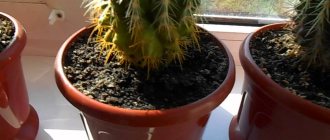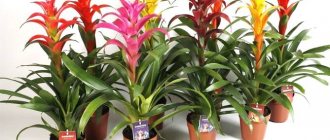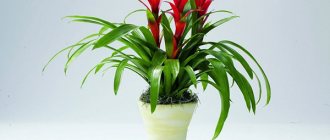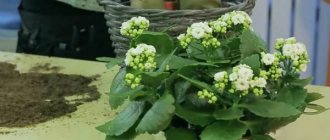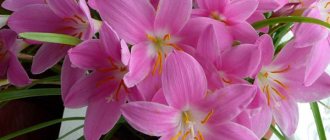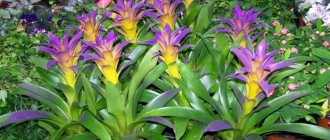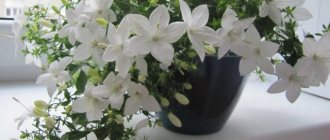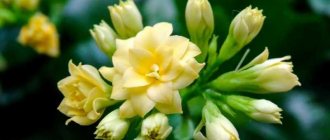How to determine that a flower needs replanting
Unlike other houseplants, guzmania does not need to be replanted regularly - unless, of course, you plan to propagate it. For the flower to feel good, just one change of place of growth will be enough - immediately after purchase, and in the future the slowly developing root system will allow it to continue to be in the existing container.
When Guzmania reproduces, its babies are transplanted into a separate pot, which appear immediately after the mother bush blooms (begins and ends in the summer). Within 2–4 months after emergence, they form their own root system, so when they reach 15 cm, they are separated from the “mother” and transferred to a separate container.
Features of guzmania care
Lighting for Guzmania
Guzmania can be grown in both light and shaded areas. She prefers diffused light; she should be shaded from direct sunlight at midday, for example, with translucent paper or fabric. Grows well on windows with western or eastern orientation. It grows well on northern windows, but may not bloom. In summer, guzmania can be taken out into the open air, but it should be protected from sunlight, precipitation and drafts. If you do not have the opportunity to place the plant outdoors in the summer, you should regularly ventilate the room.
In the autumn-winter period, Guzmania needs good lighting; during this period, shading is not required. You can create additional lighting using fluorescent lamps, placing them above the plant at a distance of 50-60 cm, for at least 8 hours a day. In the autumn-winter period, it is also necessary to ventilate the room, but drafts should be avoided.
Guzmania watering and air humidity
During the growing season (from March to October), guzmania is watered abundantly as the soil dries. Water is poured into the outlet funnels, preferably in the morning. The water in the funnels must be changed periodically. Before the dormant period begins after the gusmania blooms, the water from the outlet is drained. In winter, watering is moderate; if the content is below +20°C, water is not poured into funnels, but the plant is sprayed.
Plants placed on a bromeliad tree are removed from their support at least once every 10 days and immersed in settled water until saturated, after which excess water is allowed to drain and returned to their place.
Water for watering guzmania is used that is well-settled and soft, 2-3 degrees above room temperature.
If the plant is kept above +20°C in winter, you can occasionally pour a small amount of water into the outlet, only in the morning and always warm.
Like all bromeliads, guzmania prefers high humidity. It is optimal for it to be grown in a terrarium or a humid greenhouse. It is necessary to spray the plant several times a day. To increase humidity, the plant can be placed on a tray with damp moss, expanded clay or pebbles. In this case, the bottom of the pot should not touch the water. You should periodically wipe the gusmania leaves with a damp cloth to remove dust; using special wax to make the leaves shine is not advisable.
From May to August, fertilizing of Guzmania is carried out once a month, while the fertilizer is diluted with water for irrigation and poured into a socket. Fertilizer is used specially for bromeliads or for ordinary indoor plants, but taken in a dose four times less than for other plants. It must be remembered that the dose of nitrogen in the fertilizer should be low; its excess can cause the death of the plant.
Guzmania, Scarlet Star variety
Guzmania transplant and substrate
Guzmanias are replanted as needed, once every 2-3 years. During transplantation, the neck of the plant is not deepened; this can cause the plant to rot and die.
The substrate for growing gusmania must be porous, drainage should be at least 1/3 of the height of the pot. For epiphytic species, the mixture is made up of crushed pine bark, chopped sphagnum, high-moor peat, leafy, humus soil (or dry mullein) in a ratio of 3:1:1:1:0.5 with the addition of perlite and pieces of charcoal.
For terrestrial species of Guzmania, a substrate is prepared from leaf, humus soil, peat and sand (2: 1: 1: 0.5). Sphagnum, turf soil, coniferous tree bark, and charcoal are used as additives. The planting container should not be too deep; it is better to use wide bowls.
When can Guzmania be replanted?
In terms of replanting, guzmania cannot be called a very capricious plant, but, as when growing other indoor flowers, it is advisable to postpone this process to spring, when the root system of the emerging children is fully formed. In the fall, you can replant plants that are in shipping pots, because after purchase they will not be able to develop for a long time in such conditions. In other cases, you should wait to transplant until spring.
Preparing for transplant
Preparations in almost all cases involve the same actions: purchasing a suitable pot, preparing the soil substrate and drainage layer. However, in the case of guzmania, an important step will be additional processing of the plant itself.
Choosing a pot
Guzmania is characterized by a shallow root system, which means that the pot for it should be low but wide. Deep containers can lead to rotting of the lower part of the substrate, to which the roots of the flower simply do not grow. The ideal option would be a pot no more than 12 cm high, and the bottom 2-3 cm should be occupied by a drainage layer.
The diameter of the planting container is selected based on the size of the children being planted, but on average it is no more than 10 cm. When transplanting from a transport container of an adult plant, this value can be increased by half, and sometimes more.
Drainage preparation
The height of the drainage layer in a pot with guzmania is usually 1/3 of the total height of the product, and expanded clay, foam plastic or charcoal can be used as a moisture-absorbing material. The latter option is even more preferable, since it is an excellent prevention of high soil acidity and prevents the development of infection, while simultaneously protecting the plant from waterlogging and associated putrefactive processes.
As for the soil mixture, it should be as close as possible to the natural substrate of Guzmania. In nature, the flower often grows not in the ground, but on old wood, so you either plant it in ready-made soil for bromeliad crops, with the addition of peat, sphagnum moss and loose leaf soil, or prepare the soil mixture yourself using one of the following recipes:
- Option 1. A mixture of crushed roots of sphagnum moss and ferns (in a ratio of 1:3).
- Option 2. A mixture of coniferous bark, moss, sand and leaf soil in a ratio of 2:1:1:2.
- Option 3. A mixture of humus, sand, turf soil and peat, in a ratio of 2:1:2:4.
For any of them, it would be appropriate to use crushed charcoal, with the help of which you can increase the looseness of the substrate, even when you are already using it as a drainage layer.
Flower processing
Treatment of guzmania before transplantation is one of the main stages of the preparatory process, and it does not matter for what purpose it is performed. If we are talking about an adult, recently acquired plant, then before placing it in a new pot it would be wise to remove all damaged roots and treat the cut areas with crushed activated carbon, which will subsequently prevent rotting of the root system. The rhizome of children separated from the mother bush can be treated with a growth stimulant, using one of the popular drugs: for example, “Kornevin” or “Heteroauxin”.
Types and varieties of guzmania in indoor culture
Only a few natural species of the genus Guzmania are suitable for indoor cultivation. Finding them in garden centers and flower shops is almost impossible. There are beautiful hybrids and varieties on sale based on G. lingulata or G. monostachia. They have large, bright inflorescences, are better adapted to home conditions, and are more durable.
Guzmania lingulata
This species and its varieties are among the most common in indoor culture. The specific epithet "lingulata" means "lingual". The natural species reaches 16–30 cm in height. The inflorescence is covered with reddish bracts.
Varieties of G. lingulata:
- Var. Lingulata forms a rosette of green leaves 2.5 cm wide. The bracts are slightly curved, red or pink. Begins to bloom in March or December.
- Var. Cardinalis is a variety with long dark green leaves and purple or light red bracts. The time for flowering occurs in March or September.
- Var. Concolor is a compact variety with a height of 15 cm. It has light green leaves, pale orange and reddish bracts.
- Var. Flammea is a medium-tall plant (25–35 cm), green leaves, rich red (“flaming”) bracts. Begins to bloom in July–August.
Flaming Flammea
Hybrids and varieties of reed gusmania reach a height of 15 to 60 cm. The diameter of the rosette is 30 cm or more. The peduncle is short, thickened, in the upper part it consists of almost straight bracts of red, purple, crimson, scarlet, snow-white, and pink shades. The flowers are small, yellow-white. Flowering duration is about 4.5 months. The popular name for G. lingulata with its large bright red inflorescence is “mother’s heart.”
Minor
The word “minor” in translation means “small”. The height of the hybrid plant Guzmania Minor is no more than 30 cm. The rosette leaves are 2.5 cm wide and reddish-green in color. The bracts are bright red or lemon yellow.
Flowering lasts from February to August. The “Minor” hybrid fits even on a narrow window sill and is suitable for small spaces.
Minor Rondo
Guzmania Minor Rondo is a miniature species. The diameter of the leaf rosette is 9 cm, the height of an adult bush reaches 20 cm. The bright green leaves are spreading, up to 35 cm long. The bracts are red.
The spike-shaped inflorescence of Guzmania Minor Rondo does not rise above the leaves, but is surrounded by them, like another row of large green petals.
Hope
A spectacular indoor plant up to 40 cm high. The peduncle is torch-shaped, brown and burgundy at the base, scarlet, coral or crimson in the middle, white at the top.
Flowering begins in March or September and lasts for several months. The seeds ripen in capsules and can be used for sowing.
Tempo
A medium-sized hybrid, slightly larger than “Minor”. The height of an adult plant is 35 cm. The leaves are light green and shiny. The bracts are scarlet, the pointed tips are snow-white.
Guzmania Tempo loves moisture more than other varieties.
Optima
A low-growing variety of Guzmania. An adult plant reaches a height of less than 30 cm. The rosette is loose, the leaves grow spreadingly.
The length of the leaf blade is up to 40 cm, the width at the base is about 4.5 cm. The bracts are scarlet in color. The flowers are yellowish.
Blitz
Guzmania “Blitz” is a medium-sized hybrid with a height of no more than 35 cm. The leaf blades are wide at the base and pointed at the ends. The leaves are dense, glossy, light green in color. Bracts deep scarlet color. The “real” flowers are small, yellow, and bloom inside an elongated rosette.
Ostara
The hybrid was created by crossing the species G. lingulata and G. witmackii. The total length of the peduncles is 30 cm. The bracts are painted in a deep red color.
Guzmania Ostara blooms for 6 months (from mid-winter to mid-summer). After this, children are formed at the base of the mother plant. They quickly adapt when planting and transplanting.
Hilda
Guzmania Hilda forms a large rosette of soft green leaves with a glossy surface. In the lower part of the peduncle, the color of the bracts is dominated by light green and yellow tones. The bracts are bright yellow.
Groups of guzmania varieties and hybrids according to inflorescence color:
- Red: “Calypso”, “Minor Rondo”, “Ostara”, “Tempo”, “Confetti”, “Blitz”, “Allura”.
- Orange and yellow : “Musaika”, “Mirador”, “Deseo yellow”, “Diana”, “Flavo”, “Ritmo”.
- Pink : “Dezeo pink”, “Alerta”, “Voila”, “Etude”, “Candy”.
- White and cream : “Deseo magic white”, “Deseo white”, “Evelien”.
Guzmania Mix
Guzmania "Mix" is the commercial name for a group of commercially available hybrids. They differ in the color of their “sultans”. Bracts can be yellow, scarlet, pink or burgundy.
The maintenance conditions for most indoor guzmanias are similar, which makes it possible to plant several hybrid varieties in one pot or container. They are very attractive, unpretentious, and grow well in suitable conditions.
Guzmania single-eared (G. monostachia)
The species is used for hybridization and obtaining new varieties. The leaves are light green, about 40 cm long. G. unicolosa owes its name to the shape of the inflorescence, which looks like a thick spike.
The bracts are greenish-brown below, with purple, red or orange tips above. Small, white flowers themselves look modest, but against a red-brown background they give the plant an unusual appearance.
The variety G. monostachia “Variegata” is a plant with white stripes on green leaves and red bracts. Variegated guzmania needs a brighter location, warmth and high humidity.
How to replant a plant at home: step-by-step instructions
Depending on what part of the plant you are going to replant, this process will have certain differences, but in any case you will need the following tools:
- a sharp knife (used to cut off children from the mother bush or remove damaged roots of an adult plant);
- shovel for pouring soil;
- growth stimulator for treating the root system (for example, “Kornevin”);
- landing capacity.
An adult plant can be moved to a new pot using the transfer method, after slightly drying the old soil. There is nothing difficult about this, the main thing is to prepare a suitable soil mixture and a larger pot.
Transplanting children will be more interesting and responsible, so it is advisable to adhere to the following plan of action:
- To begin, remove the mother plant from the pot and carefully remove the root system of the selected Guzmania babies from the old substrate (most often you have to use a knife to separate it).
- Place them on a clean sheet of paper and leave to dry for about an hour. Treat the roots with the prepared solution for better rooting.
- Place a drainage layer in the new pot so that it takes up one third of the total available space.
- Make a small mound of soil and place the root rosette of the plant to be planted in the center.
- Carefully level the roots and sprinkle them with soil substrate, up to the level of the root collar.
- Lightly compact the soil and spray it with settled water from a spray bottle.
At this point, the transplantation of guzmania can be considered complete and all that remains is to move the pot to a suitable place, further providing appropriate care for the rapid rooting of the young flower.
Video: features of development and transplantation of Guzmania
Care Tips
With the onset of summer, the flower is taken out into the fresh air, but protected from the sun, drafts and precipitation. The room in which the plant is located is regularly ventilated.
Guzmania loves moist air, so make sure that there is damp moss or expanded clay in the tray. The plant is sprayed on hot days up to three times a day. Place saucers of water next to the pot and wipe the leaves with a damp cloth.
The dormant period lasts from October to February. At this time, the flower is watered less often and not sprayed. Caring for guzmania at home is based on maintaining day length, air humidity and moderate watering. The flower must be illuminated for at least nine hours, so in winter it is illuminated with a phytolamp.
Irrigation features:
- The plant is watered every day in the morning in the summer and once a week in the winter.
- Water is used filtered or settled for 24 hours.
- Excess moisture is drained, otherwise the socket will rot.
- Plants grown on a support are removed and immersed in a basin of settled water, then returned to their original place.
The plant requires feeding during the active growing season in summer and spring once every three weeks. It is advisable to use special nutrient mixtures for bromeliad crops. Universal fertilizers are used, but their concentration is reduced by three times. They water the plant through the outlet.
Problem solving:
Care at home (transplanting into the ground and watering), if done incorrectly, causes the death of the flower or its weakening. If the leaves become covered with gray spots, they are treated with fungicides. The scale insects are collected by hand and the flower is sprayed with insecticides. The leaf blades are wiped with a cotton swab dipped in a soap solution to protect against spider mites and mealybugs.
Features of care after transplantation
Correctly performed transplantation is only half the battle on the way to obtaining a beautiful and blooming guzmania flower, therefore, so that all the efforts made are not in vain, be sure to take into account several requirements for further care.
Location and optimal conditions of detention
Regardless of the season, the transplanted plant should always be placed in a fairly warm room with moderate lighting and no drafts. However, specific temperature conditions and air humidity in summer and winter will have their differences, so when organizing conditions for the growth and development of Guzmania, you should focus on the following indicators:
Watering and fertilizers
On the first day after transplanting the flower, it will be enough to thoroughly wet the soil in the pot and add a small amount of liquid to the outlet. In this case, the liquid used must be soft, filtered and relatively warm, for which the water in an open container is left in the room for a day. Hard cold water straight from the tap is detrimental to the plant, especially since in this case the liquid is applied not into the soil, but into the rosette formed by the leaves, filling it to 2/3 of the total volume.
In summer, it is enough to moisturize guzmania once every two days, and in winter - no more than once a week. Fertilizers for Guzmania are not a vital component of care, since in its natural habitat it receives nutrients in minimal quantities. However, by feeding indoor flowers at home, you can not only stimulate flowering, but also prolong it, which will allow you to admire the plant for 2-3 weeks longer than usual.
To fertilize the exotic beauty, you can use universal compounds developed to enhance the decorative properties of flowering plants (for example, Agricol, Stimovit, Biopon). Before adding to the soil, any of them must be dissolved in water, which will help avoid overfeeding the plant. Moreover, in the case of guzmania, a single dosage should be approximately 4-5 times lower than that recommended by the manufacturer. Treatment of plants with the prepared mixture is carried out from May to September, no more than once a month.
Flower propagation
Propagation of Guzmania can be done in one of two ways: using purchased seed material or by separating the children formed on a dying mother plant. If you purchased an already mature flower, be prepared for the fact that you will soon have to take care of its renewal, because the average lifespan of this plant is 2-3 years, and some specimens die off much earlier.
In any case, with proper cultivation, new specimens (“babies”) always grow next to the mother plant, which need to be moved to a separate container. When propagating guzmania by seed, purchased seeds must first be disinfected in a weak solution of potassium permanganate, and then sown in small containers filled with a mixture of peat and sand (in equal proportions).
Germination of seeds is carried out in a warm room, with a stable temperature of at least +25°C and high humidity, which can be achieved by covering the seedlings with oilcloth and regularly spraying the soil with water from a spray bottle. Usually the first sprouts appear after three weeks, and after another 7 days they will need to be picked into separate cups. If all actions are performed correctly, then the emerging seedlings will quickly catch up with the planted children.
Description of the flower
In its natural environment, the plant of the bromeliad family grows in the tropical forests of South America. It clings to the bark of trees with its roots, but is not a parasite, since it obtains food from moist air. When grown at home, the culture does well in flower pots.
Guzmania forms a cup-shaped rosette of long, linear leaves with longitudinal venation and entire edges. There are mosaic varieties with variegated leaves.
The bright, eye-catching bract on an erect peduncle is painted in bright colors that contrast with the lush green foliage. If you collect several varieties of crops in a greenhouse, you can admire different shades of red, brown, and yellow flowers.
Guzmania reaches a height of 0.45–0.7 m with a rosette diameter of 0.5 m. Flowering with small white-yellow flowers begins at 2–3 years and lasts 6 months. The decorative shape of the inflorescence is interesting - paniculate pyramidal.
Guzmania in nature
At the end of flowering, the life cycle of the rosette ends. Exotic plants from the tropics decorate living spaces and offices. Amateur flower growers are interested in what guzmania brings to the house, besides beauty and harmony. It is believed that the flower:
- heals unstable psycho-emotional states, erectile dysfunction;
- acts as an antiseptic, destroying pathogens;
- creates a favorable environment in the home;
- relieves insomnia and nightmares;
- awakens creativity;
- strengthens relationships in couples, increases the well-being of the family.
In addition to the positive effect on humans, guzmania causes harm. The leaves contain milky juice, which causes painful symptoms in people prone to allergies.
Typical mistakes during transplantation
By paying attention to some important details of transplantation and further care of guzmania, you will be able to avoid many problems.
First of all, we are talking about this:
- Lack of flowering of the plant, which is explained by a lack of moisture, heat or light. To prevent this, children planted in pots should be placed only in a well-lit place, with a suitable temperature and humidity (shown in the table above).
- Rotting of Guzmania immediately after transplantation or during further cultivation. In any case, the main reason for this phenomenon lies in the excessive amount of moisture due to frequent watering and spraying.
- Death of young shoots. If the transplanted plant looks lethargic and soon dies, check the temperature in the room. Typically, such consequences result from prolonged exposure of the flower to temperatures below +12…+13°C.
- Short flowering. The occurrence of this problem is often explained by moisture getting on the opened flower petals, so when watering guzmania during the flowering period, it is advisable to add it to the root.
- Slow growth of the transplanted shoot. Be sure to monitor the quality of water used for irrigation. The slightest admixture of chlorine or low temperature of the liquid will negatively affect development.
- Infection with infectious diseases. If the first signs of the disease became noticeable soon after transplanting the guzmania, then it is likely that it was caused by a violation of sanitary standards when pruning children or when preparing the soil.
- Drying of the transplanted parts. The main reason that plants do not take root in a new place of growth is their lack of a sufficiently developed root system. Simply put, you can separate them from the mother bush only if there are a large number of clearly visible roots.
- Drying leaf tips. Perhaps the indoor air is too dry and young plants need more frequent spraying.
Although these are not all, they are the most common problems with guzmania, so every gardener should know about them. To normalize the condition of a flower, it is enough to review the conditions created for it and make appropriate adjustments. In extreme cases, you will have to replant the plant again without repeating previous mistakes.
Possible problems and pest protection
Indoor Guzmania flowers are little susceptible to infections in the absence of serious errors in care. A number of problems arise when there is excess water: rotting of the roots and base of the rosette, fungal diseases. The tips of the leaves dry out due to the dry air in the room and become covered with light brown spots as a result of sunburn.
Leaves become lighter and grow poorly when there is a deficiency of nitrogen and potassium. An excess of nutrients also negatively affects the appearance of guzmania.
If the plant does not bloom for a long time, then perhaps the soil in the pot is poor in phosphorus. Daughter shoots are not formed if there is a lack of basic nutrients.
Scale insects or scale insects may appear on Guzmania. They are difficult to remove using folk remedies, because these pests are well protected by chitinous cover. Remove insects with a sponge soaked in Actellik solution and water the soil with the same preparation. If chemicals do not help, the infected plant should be destroyed. Spider mites can be washed off leaves in the shower. Chemical preparations for the destruction of these pests are insecto-acaricide Oberon, acaricide Sunmite.
Keeping it in warm and humid conditions and timely eliminating errors in care are measures that will help avoid disappointment if the guzmania “reluctance” to bloom. A tropical beauty with bright, large inflorescences looks charming in the interior. When planning to purchase a guzmania, think about whether in your conditions it will be possible to provide the necessary light and watering care, and whether the plant will be comfortable in your living room, office or study.
When and how to separate Guzmania babies?
The peculiarity of Guzmania is that flowering for it is the final stage of development. After the peduncle dries, the guzmania itself begins to dry out. However, for procreation, young baby bushes remain in the pot, which are formed during the flowering process.
Sometimes the mother bush does not dry out and continues to exist for some time, but it will no longer bloom, and after a certain period it will die anyway.
Some gardeners leave the babies in the same pot, removing only the dried part of the old plant from it, especially if only one sprout has formed. In principle, you can do this too - new bushes usually develop well and even bloom. But it is worth considering that this will affect the decorativeness of the bush, because there will be a void in the place of the parent plant. It is best to transplant the Guzmania babies into a separate container. Thus, you can get a compact, beautiful bush and at the same time propagate the flower.
Frequently Asked Questions on Growing Guzmania
- Why is guzmania not growing?
If you keep a plant in the same pot without fertilizer for many years, then it is most likely suffering from nutrient deficiency. This applies to both “babies” and adult plants. Another reason may be improper living conditions. It is possible that the plant has grown and is simply preparing to flower and reproduce. Take your time, everything has its time.
- Why doesn't Guzmania bloom?
As mentioned above, the reason for this is a lack of light, moisture or fertilizer. Experiment with the conditions, and in a month and a half the plant will delight you with a beautiful flower.
- Why do Guzmania leaves wither?
Either you overdid it with watering, or you overexposed the plant to the light. Another reason could be pests.
- Is the plant poisonous?
The leaves and flowers are not poisonous, but you should avoid getting the milky juice on the skin and mucous membranes, as it can cause either irritation or an allergic reaction. Overall the plant is quite safe if you have children or dogs and cats.
When to replant?
Guzmania babies will be ready for separation no earlier than they have formed their own root system. As soon as the peduncle on the mother plant begins to fade, it should be cut off so that the flower does not waste its strength in vain, but directs it towards the active development of the children.
At the same time, you must stop watering the guzmania in the outlet, otherwise the plant will rot.
Transplantation of Guzmania children must be done in the spring. If young shoots appeared in the autumn-winter period, it is better to postpone the procedure until March.
Diseases and pests of Guzmania, methods of combating them
Although guzmania can withstand unfavorable environmental conditions quite steadfastly, it is susceptible to infection by a variety of pests.
- Its main enemies are scale insects, spider mites, and mealybugs. They live on leaves and damage them. To treat, you need to wipe the plant with a sponge, after soaking it in a soap solution. If this does not help, then extreme measures are needed - the use of insecticides that are sprayed or poured into an outlet.
- If you see that the stem has begun to rot , then most likely the root system has rotted. To do this, you need to moderate watering.
- Gray spots on the leaves are a sure sign of fungus. A fungicide solution helps get rid of it.
How to replant?
When the children grow good roots, it is necessary:
- remove them along with the old flower from the flowerpot;
- Using a sharp knife, carefully cut off each baby, trying not to damage the young roots;
- let dry a little;
- treat the roots in a growth stimulator.
To plant children, you need to choose a pot no more than 12 cm high. In a deep flowerpot, flowers will quickly disappear from excess moisture, since the soil will not have time to dry out. As for the soil, a special substrate for bromeliads is suitable, to which you need to add a little sand, bark and leaf soil.
The planted children should be watered into the outlet, covered with a bag on top and placed in a shaded place until the end of rooting. Then the flowerpots are moved to a bright window.
Transplantation of Guzmania babies - video
Reproduction methods
Guzmania reproduces in two ways:
- children;
- seeds.
In most cases, the mother plant dies after flowering ends - the peduncle and leaves gradually turn yellow and die. Therefore, after the babies appear, they need to be separated and planted in separate pots - this is a natural process for the plant.
It is very rare, but it still happens when guzmania continues to grow for some time after it has flowered. It will, of course, not bloom a second time, but until it wilts it can produce another baby.
Therefore, contrary to the popular advice to throw away the mother plant after separating the children, it is better to leave it to grow - just in case. But if there are signs of imminent death - yellowing and drying of the leaves, you don’t even have to try to save the old guzmania.
By the way, if the children are not separated, the flower will continue to grow and even bloom in the old pot. This happens due to the fact that before dying, the mother plant forms a common root system with the children. But the dead Guzmania is in the zone, violating the aesthetics. And for an ornamental plant, appearance is very important.
Photo: Guzmania
Children
Raising children at home requires certain skills. So, first of all, only grown plants, at least 10 cm in length, are separated. This is necessary so that the plants have already formed a root system.
You can’t tear your children away from Guzmania! First, carefully remove the entire plant from the pot.
Carefully, trying not to damage the fragile roots, remove the lower leaves that formed the bed for the young plant. The babies are cut off with a sharp knife, preferably sterilized, and the cut site is treated both on the baby and on the mother plant with garden varnish
If you don’t plan to save the old guzman, it doesn’t have to be processed.
If there are several children, the root system must be divided so that each new plant receives its own root. But even if by chance one of the children separated without roots, do not be upset! You can try to root it by immediately planting it in the substrate and watering it with a root former. If the correct temperature and humidity are maintained, the young flower has a fairly high chance of taking root.
Soil and conditions for planting children
In order for all the plants to take root, you need to place them in a suitable substrate - you can purchase ready-made soil for bromeliads, sold in flower shops, or mix yourself one part of sand, two parts of humus and turf soil and four parts of peat. A ready-made mixture for ferns or orchids is also suitable.
The main thing to remember is that epiphytes in nature grow not in the ground, but on other plants. Therefore, the soil for keeping in pots should be light and permeable. No heavy mixtures that clump together after watering!
Drainage and a little substrate are laid out at the bottom of a shallow pot, the baby is carefully placed on it and sprinkled with earth in a circle. You can lightly compact the soil on top, but do not compact it. For the first time, the planted young guzmania is watered both into the outlet and around it, wetting the ground. After this, you only need to water into the outlet, draining the unabsorbed water.
It is better to choose heavy ceramic pots, since grown flowers can overturn them with the weight of the leaves. In the first two weeks, it is advisable to cover the planted plants with film to create increased humidity. In this case, they need to be sprayed daily with warm purified water and kept at a temperature of about 25°C.
Young plants should be watered carefully, without flooding the soil. It’s better to underwater a little than to overwater and thereby destroy the fragile root system.
Seeds
In this case, you need a slightly different soil - a mixture of peat and sand in equal quantities. Seeds are laid on top of a damp substrate without covering them - they need light to germinate. The seeds are first washed in a solution of potassium permanganate and then dried. The container is placed in a bright place, but avoiding direct sunlight. Cover with glass or film.
Popular articles Description and features of the use of the soap row mushroom
Periodically, as the soil dries, it is moistened from a spray bottle with warm, purified water, while ventilating the container. If the temperature was maintained correctly - about 23°C - shoots should appear in 2-3 weeks. The shelter is not removed until the seedlings are planted in separate pots, that is, after 2 months.
The seedlings are planted in a mixture of part turf, two parts leaf soil and four parts peat. And only after six months they are transplanted into permanent pots. Young guzmanias will bloom only after a few years, sometimes it takes as long as five years.
Photo: Guzmania
Dropping off children at home
Guzmania or guzmania is a fairly popular annual plant from the bromeliad family. Reproduction of the decorative crop is carried out by separating the newly formed lateral shoots left after the death of the parent plant, as well as by seed. The first option in indoor floriculture has become the most popular and is carried out in accordance with the following technology:
- the lateral shoot is formed at the stage of the flowering period of the parent plant and over time transforms into a separate, full-fledged plant;
- after the shoot reaches a height of 14-16 cm, it can be separated and planted in a separate flower pot;
- Well-developed Guzmania shoots have three to four leaves and have a fairly well-developed root system.
The best varieties for home
If a florist has a desire to decorate their home with such exotic flowers, the first thing they start doing is choosing a variety. In nature, this plant is a fairly bright mix of colors, and in culture there are even more of them!
The most popular varieties of Guzmania are the following:
| Variety name | Description |
| Rondo reed Minor | A variety with white flowers that are beautifully set off by red stipules and dark green foliage. The plant has a short stem and compact size. The root system of the variety is very weak |
| Donell Smith | The plant's bright lemon flowers blend seamlessly with pale green foliage. The peduncle is elongated, with bright red stipules, pyramidal in shape. After flowering, it forms seeds that are used by breeders to create new varieties. |
| One-Eared Minor | A variety with yellowish-green leaves and a very bright peduncle with stipules streaked with brown or pink. |
| Mosaic Minor | A variety with decorative variegated leaves and a spreading rosette shape. The variety is distinguished by bright pink stipules and small pale yellow flowers. |
| Nicaraguan Tempo | The leaf blades of the variety are green, the peduncle is small, immersed in a rosette of leaves. Flowers reddish-orange, stipules bright red |
Flower lovers often prefer to grow red guzmanias, as they are believed to bring harmony in relationships into the home. Whether this is true or not, everyone can find out from their own experience. Fortunately, this flower does not require much effort.
How to transplant guzmania (video)
In some cases, the parent plant does not die after the formation of a shoot, but develops further and forms new shoots. As a rule, after flowering, indoor guzmania fades and the peduncle must be removed, which allows not only the formation, but also the growth of children. To stimulate growth processes, it is advisable to install the indoor plant in the shade and stop irrigation activities . Most often, in such conditions, the process of forming a full-fledged process takes about three months. It is strictly forbidden to separate and transplant children that have not formed a root system.
It is advisable to transplant the children to a permanent place in separate flower pots in the spring , which will allow the young plant to adapt to the new growing location as quickly as possible. You can also grow guzmania with seeds, which need to be disinfected in a pink solution of potassium permanganate, slightly dried to a free-flowing state and sown on the surface of a previously prepared soil substrate.
Main problems
In the process of growing indoor guzmania, beginning gardeners may encounter some difficulties.
It is important to know about them in advance in order to take effective measures
Violation of containment conditions
Improper soil composition leads to disruption of the growth and flowering of indoor guzmania. This problem can be solved by choosing the optimal soil for the plant. It must have a light airy structure. Additionally, the following components should be added in equal parts:
- peat;
- coarse sand;
- leaf soil;
- turf land;
- sphagnum moss.
Wrong location
Too dark places in the apartment, as well as places under direct sunlight, have a bad effect on the well-being of Guzmania. The tips of its leaves may dry out and flowering may stop.
Poor nutrition
Indoor guzmania feeds primarily through the leaves. Do not apply fertilizers directly to the soil, as this causes burns to the root system.
Excess moisture
Excessive amount of water in the soil leads to rapid rotting of the roots and base of the stem. To avoid this, you need to ensure effective drainage in the pot. It is also necessary to promptly drain from the outlet the water that the plant did not drink, unless it has evaporated.
Lack of water in the outlet
The lack of water in the plant's rosette, combined with too dry air, leads to drying out of the leaves and roots. Therefore, you need to carefully monitor the general condition of the guzmania, and if the water in the funnel evaporates, add about a third of it.
Sunburn
Burns from direct rays of the sun provoke drying and curling of the tips of the leaves, as well as covering the entire leaf surface with unattractive brown spots.
Spraying with hard cold water
Guzmania, being a typical tropical inhabitant, does not tolerate cold, hard water, especially if it contains particles of calcium and chlorine. The water for spraying leaves should be left for 24 hours and then passed through a filter.
The peduncle was not cut
Sometimes Guzmania owners do not cut off the peduncle in a timely manner, waiting for the plant's seeds to form. In this case, the process of formation of new fresh shoots slows down significantly.
Rules for choosing a pot and soil for replanting Guzmania
The soil mixture for growing an ornamental crop of this species must be quite specific, which is due to the characteristics of the growth of Guzmania in natural conditions. In its homeland, this crop uses not soil, but old plant wood for nutrition. In indoor floriculture, guzmania can be planted in ready-made soils intended for growing bromeliads.
The soil sold in flower shops is also perfect for growing orchids. Experienced flower growers and specialists in the field of cultivation of exotic plants recommend adding pine needles, as well as crushed charcoal, to a ready-made soil substrate based on peat, sphagnum moss, pieces of tree bark and loose leaf soil, which will improve the looseness of the soil and also make it as light as possible and optimally suitable for bromeliads.
Beauty without effort
There is no need to think that all exotic plants require special care.
The best example of this is guzmania, which at home without much hassle will delight you with its splendor and bright colors. Let us consider the attitude of the species to the main factors influencing its growth and health.
Lighting. Like most flowers, guzmania does not tolerate direct sunlight. Western or eastern window orientation is desirable. But in winter, move the guzmania to the south side to give it more light.
It is better not to place a flower on the windowsill: in summer it will be hot from the sun, and in winter - from the heating system.
Water. Regarding watering, caring for Guzmania is quite simple. Remember a few simple tips:
- Guzmania does not need to be watered very often, only when the soil dries out. Excess water will inevitably lead to rotting of the root system.
- Moisten the soil only if the air is extremely dry or if it is very hot.
- Experienced flower growers advise not to water the soil, but to pour water into the funnel as needed, as it happens in natural conditions. It is advisable to change the fluid in the “accumulator” at least once every two months.
Water collected during rain is ideal for irrigation, but this option is not always convenient, so you can use lukewarm water that has settled.
Humidity and temperature. Guzmania loves moist air, so the optimal level of this parameter is 60–85%. In summer, if possible, it is better to place the plant in the shade on the street or on a loggia; in winter, a bathroom with a window would be the ideal place.
At home, it is recommended to use a humidifier.
Guzmania prefers warmth to cold. Temperatures below 12°C can destroy the flower.
Advice. It is not recommended to place guzmania in a draft, as this can cause plant disease.
Vitamins. It is necessary to enrich Guzmania when it blooms - from March to August-September. Buy special fertilizer for bromeliads at the flower shop and feed your beauty about once every 2-4 weeks.
The procedure is simple - dilute the complex with water and pour it into a funnel.
If guzmania blooms well for several months, then it does not need to be fertilized at all.
How to separate Guzmania babies (video)
When preparing your own soil mixture for growing guzmania, you can mix three parts of leaf soil, one part of pine bark and one part of medium-grained river sand. Before planting the plant, it is necessary to disinfect the soil mixture using high-temperature conditions in the oven.
You should not use too large and voluminous planting containers for transplanting and planting decorative indoor crops. The flower pot must match its size to the relatively small and superficial root system of the guzmania. It is best to purchase a shallow, medium-sized flower pot for growing. The main condition for proper transplantation is the creation of a good drainage layer in the planting container and the presence of high-quality drainage holes. Only in this case will it be possible to prevent stagnation of moisture in the soil and save the ornamental crop from rotting roots.
Guzmania transplant technology
As a rule, adult plants die after flowering and do not require replanting, but it is recommended to plant or replant shoots of an ornamental crop very carefully, according to the following technology:
- carefully release the root system of the planted shoot or young ornamental plant;
- lay the extracted plant on a dry surface for about an hour;
- treat the roots of the transplanted crop with a rooting stimulator, which can be “Kornevin” or “Heteroauxin”;
- pour a drainage layer into the flower pot, the volume of which should be approximately a third of the planting capacity;
- fill up a raised area of fertile soil and install a young rosette of a decorative indoor plant;
- very carefully sprinkle the roots of the young plant with a nutritious soil substrate prepared in advance to the level of the root collar of the plant.
How to care for guzmania (video)
It is very important to remember that the root system of any type of guzmania is very fragile, so compacting the soil in a flower pot is strictly forbidden. After planting, abundant watering is carried out, and, if necessary, nutrient soil is added. Watering the planted plant is carried out in the leaf rosette with settled water at room temperature with the addition of a few drops of “Kornevin”. Further care of the plant consists of watering, fertilizing, and also carrying out preventive measures.
Sources:
https://fermer.blog/bok/komnatnye-rasteniya/bromelievye/1544-peresadka-guzmanii.html https://glav-dacha.ru/kogda-i-kak-otdelyat-detok-guzmanii/ https://dachadecor .ru/komnatnie-rasteniya/technologiya-i-sroki-peresadki-guzmanii

